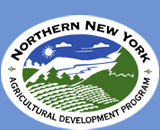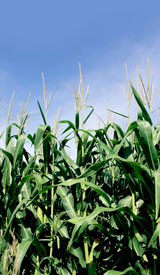February 1, 2010
Contacts: listed at end
NNY Dairy Herd Research Offers Insight on Improving Milk Check
Income
NNY farmers said to receive lowest prices; research offers ways to
improve milk components
Dairy farmers struggling to hold on until milk prices recover are
looking for ways to add income now. With funding from the Northern New
York Agricultural Development Program, Cornell University researchers
collected and analyzed data from 52 Holstein dairy herds in Northern New
York to help farmers learn how to increase milk protein levels which
bring a premium from processors.
Dr. Mark Stephenson of Cornell University’s Program on Dairy Markets and
Policy concluded in a 2005 report that NNY dairy farmers consistently
received the lowest milk price per hundredweight (cwt) and that
improving the production of milk components, such as milk fat and
protein, could add income under our multiple component pricing plan.
Stephenson says, “With the current pricing structure, the value of milk
fat and milk protein account for more than eighty percent of the milk
price received for 100 lbs. of milk and higher milk protein levels
equate to higher cheese yields/unit of milk. Higher component milk is
better for farmers and dairy processors in the North Country.”
Research Project Leader Larry E. Chase, a Cornell University animal
science professor, says, “Milk components – the pounds of milk fat and
milk protein - are critically important in determining the size of
producers’ milk checks, and a large number of factors affect component
levels. Our work with dairy farmers in Northern New York has provided a
basis to help herdsmen adjust their production practices to increase
milk protein levels that bring a premium.”
The research team used October 2009 pricing from the Federal Milk
Marketing Order No. 1 for Northeastern farms to calculate the potential
impact of improving components.
“The price per 100 lbs. of milk increases by 26 cents/100 lbs. if milk
protein increases by 0.1 point. For a cow producing 70 lbs of milk per
day that equates to an increase of 18 cents per cow per day,” Chase
says.
Chase says, “Balancing the dairy ration fed to cows is one way farmers
can improve milk protein levels. Farmers need to design a feeding and
management program that enhances the production of milk protein content
and yield by providing the right quantity and profile of the
intestinally-absorbed amino acids in their feed ration.”
The “Can We Feed for Higher Levels of Milk Protein” article posted on
the Northern New York Agricultural Development Program website at
www.nnyagdev.org offers suggestions for evaluating a dairy herd before
amino acid balancing and how to develop an amino acid formulation dairy
ration.
How long does it take to see results?
Chase says, “Once you have your management plan in place, you should see
a response within a couple of weeks.”
Chase says if no response is seen, farmers can begin the process again
and continue until the balance shows results in the milk tank and the
farm check. He notes attention to the cows’ breed, genetics, season and
stage of lactation should also be factored into the feeding and
management plan to improve components production.
William H. Miner Agricultural Research Institute President Richard J.
Grant has overseen dairy nutrition and feeding research at the Chazy,
NY, farm research center. Grant suggests, “If farmers have a milk fat
percentage that is too low, the following practices should be considered
to help raise milk fat levels:
• Limit polyunsaturated fatty acids as free oil (not contained in an
intact seed such as corn oil in distillers grain)
• Feed more saturated fat sources
• Feed recommended levels of oilseed (< 4-5 lb/cow/day)
• Increase forage level
• Increase forage particle size or length
• Add sodium bicarbonate buffer at 0.75 percent of the ration dry matter
to help raise milk fat if rumen pH is low
• Shift from high-moisture, pelleted, or steam-flaked corn to dry corn
if starch levels are high
• Shift to total mixed ration
• Feed more frequently and push up feed more often
• Reduce feed sorting.”
Factors that may be lowering milk fat levels include:
• Higher milk yield (may be causing lower milk fat by dilution)
• Loss of body condition
• Starch levels over ~28 percent of ration dry matter
• Rumen acidosis (may be lowering milk fat with higher milk protein)
• Improper milking procedure.
More information on dairy production is posted on the Northern New York
Agricultural Development Program website at www.nnyagdev.org. The
Program is guided by more than 60 farmers from Clinton, Essex, Franklin,
Jefferson, Lewis and St. Lawrence counties and provides small grants for
on-farm research to identify production efficiencies and profitability
strategies for the NNY region’s farmers. # # #
Contacts:
• Mark W. Stephenson, Cornell University’s Program on Dairy Markets &
Policy, 607-255-0324
• Larry E. Chase, Cornell University Animal Science Professor,
607-255-2196
• Richard J. Grant, W.H. Miner Agricultural Research Institute,
518-846-7121 x116
Resources:
www.nnyagdev.org
NNYADP Chairs: Jon Greenwood, Canton, 315-386-3231
Joe Giroux, Plattsburgh, 518-565-4730 (M-F 9-4)
Cornell Cooperative Extension Dairy Educators:
• Clinton/Essex/Franklin Counties: Regional Dairy Specialist Emily
Myers, cell: 518-353-4949
• Jefferson County: Ron Kuck, 315-788-8450
• Lewis County: Frans Vokey, 315-376-5270
• St. Lawrence County: Brent Buchanan,or Betsy Hodge 315-379-9192
Growing the NNY Milk Supply Fact Sheet:
www.nnyagdev.org/nnydairyfiles/DVIGrowFS206.pdf



